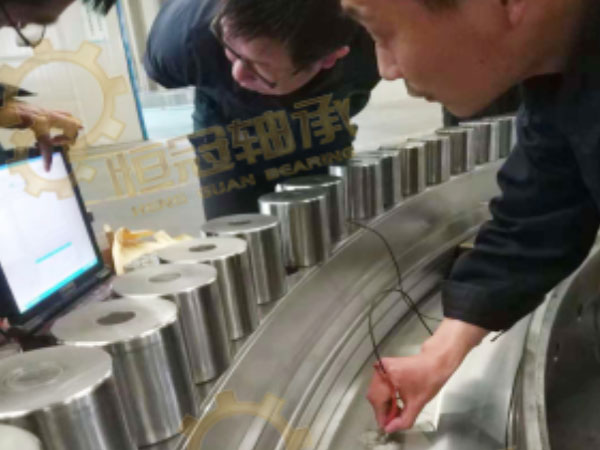Analysis of slewing bearing raceway and rolling element damage
Due to incorrect installation of the slewing bearing raceways and rolling elements, overload operation, poor heat treatment, unreliable sealing devices, etc., premature failure of the slewing bearing raceways and rolling elements. The typical damage symptoms are listed below and the main causes of the damage and the effects on the slewing work are described.

1. Slewing bearing raceway peeling off
The slewing bearing raceway is also called the raceway erosion. This phenomenon is generally caused by poor heat treatment. Usually, the surface hardness of the raceway is too high and the hardened layer is relatively thin, and the interface layer of high hardness and low hardness is caused by the alternating stress. It is characterized in that the exfoliate is in the form of a sheet. This damage can also occur at the junction of the raceway tempering soft belt.
2. Slewing bearing raceway and roller damage
(1) If the roller is skewed or the axis of the race is skewed, it will cause raceway scratches.
To avoid scratching the raceway at the end of the roller, the length of the roller in the slewing bearing of the cross roller is usually shortened by 0.5-1 mm from its diameter. If the roller is excessively shortened or the upper and lower races are separated due to slack of the connecting bolt, the gap between the end face of the roller and the raceway is increased. The skew of the roller increases the skew angle between the end face of the roller and the raceway. If there is a defect in the raceway (low hardness, unevenness, etc.), the roller edge is damaged due to the increased skew of the roller. In addition, if the roller is stuck in the diagonal direction, the end face chamfer in the diagonal direction of the roller is damaged, and even the slewing bearing is braked.
(2) The surface of the slewing bearing raceway is insufficient in quenching hardness, which may cause partial raceway scratches.
(3) When the slewing bearing is assembled, if the slewing bearing is inadvertently impacted, the roller is skewed and the force applied during assembly is too large, the raceway of the raceway may be damaged.

3. Slewing bearing raceway wear
There are several reasons for the wear of the slewing bearing raceway:
(1) Due to dust, sand, dirt and other particles mixed in the lubricating oil, the abrasive acts on the raceway and the rolling element, causing invisible metal peeling or peeling, which can be felt in severe cases. Degree. In order to prevent such wear, the support should be provided with a reliable sealing protective device to prevent external media such as dust, dirt and moisture from intruding into the raceway.
(2) When the lubricating oil is lacking in the slewing bearing or the lubricating oil is insufficient, under the action of heavy load, the raceway wear will be intensified due to the dry friction or semi-dry friction of the rolling element and the raceway.
4. The reason for the slewing bearing raceway to produce the grain
(1) The material itself is defective or improperly heat treated.
(2) When the rolling element and the raceway rotate, the contact fatigue stress is large and fatigue cracking occurs.
5. Wear of the slewing bearing rolling elements
The cross roller slewing bearing has a plurality of sliding friction surfaces, the end faces of the rollers and the friction between the outer rollers and the raceway surfaces. The latter type of friction is often point contact at the beginning, the unit contact pressure is high, and it is in dry friction and semi-friction state, resulting in wear, but as the contact area increases, the unit pressure decreases, and the lubrication condition of the contact surface is improved. , so that the degree of wear is controlled. After this stage, a 2, 4 mm wide wear band is formed on the outer circumference of the roller, which does not impair the working ability of the roller and the support.
6. Slewing bearing steel ball fragmentation
Steel ball fragmentation may occur due to defects in the material or heat treatment of the steel ball, as well as improper holding or use of foreign objects. This can be judged from the sudden increase in the rotational resistance of the support and the abnormal sound at the time of turning. If it is not eliminated in time, the broken steel ball can scrape off the large metal of the raceway, and even the thickness of the raceway is reduced. The head of the fastening screw on the support moves down to the fixed frame, causing the machine to lose the turning ability. In addition, sometimes the broken steel ball is embedded between other steel balls and theraceway, which also causes the machine to lose its ability to turn.




